Exploring the Spatial Distribution of Toponyms and Its Correlation with Landscape Characteristics: A Case Study in Wuhan, China
Abstract
1. Introduction
2. Materials and Methods
2.1. Study Area and Data Sources
2.2. Research Methods
2.2.1. Classification of Toponymic Cultural Landscape
2.2.2. Kernel Density Estimation
2.2.3. Standard Deviation Ellipse
2.2.4. Nearest Neighbor Index
2.2.5. Parameter-Optimized Geodetector
3. Results
3.1. Classification Results of Toponymic Cultural Landscape
3.2. Spatial Distribution Characteristics of TCL
3.2.1. Spatial Distribution Characteristics of Toponyms in the Natural Landscape Category
3.2.2. Spatial Distribution Characteristics of Toponyms in Humanistic Landscape Category
3.3. Analysis of the Correlation Between Spatial Distribution of TCL and Landscape Characteristic Elements
3.3.1. Evaluation Index System of Influential Factors
3.3.2. Analysis of Influencing Factors
- (1)
- Analysis of Influencing Factors on Toponyms in the Natural Landscape Category
- (2)
- Analysis of Influencing Factors on Toponyms in Humanistic Landscape Category
3.3.3. Analysis of Interaction Between Influencing Factors
- (1)
- Natural Landscape Toponyms
- (2)
- Humanistic Landscape Toponyms
4. Discussion
4.1. Analysis of Formation Origins of TCL in Wuhan
4.1.1. Natural Factors
4.1.2. Humanistic Factors
4.2. Research Value of TCL in Wuhan
4.3. Limitations and Future Work
5. Conclusions
Author Contributions
Funding
Data Availability Statement
Conflicts of Interest
References
- Atik, M.; Swaffield, S. Place Names and Landscape Character: A Case Study from Otago Region, New Zealand. Landsc. Res. 2017, 42, 455–470. [Google Scholar] [CrossRef]
- Calvo-Iglesias, M.S.; DÍaz-Varela, R.A.; MÉndez-MartÍnez, G.; Fra-Paleo, U. Using Place Names for Mapping the Distribution of Vanishing Historical Landscape Features: The Agras Field System in Northwest Spain. Landsc. Res. 2012, 37, 501–517. [Google Scholar] [CrossRef]
- Moreira, F.; Queiroz, A.I.; Aronson, J. Restoration Principles Applied to Cultural Landscapes. J. Nat. Conserv. 2006, 14, 217–224. [Google Scholar] [CrossRef]
- Antrop, M. Why Landscapes of the Past Are Important for the Future. Landsc. Urban Plan. 2005, 70, 21–34. [Google Scholar] [CrossRef]
- Alivizatou-Barakou, M.; Kitsikidis, A.; Tsalakanidou, F.; Dimitropoulos, K.; Giannis, C.; Nikolopoulos, S.; Al Kork, S.; Denby, B.; Buchman, L.; Adda-Decker, M.; et al. Intangible Cultural Heritage and New Technologies: Challenges and Opportunities for Cultural Preservation and Development. In Mixed Reality and Gamification for Cultural Heritage; Ioannides, M., Magnenat-Thalmann, N., Papagiannakis, G., Eds.; Springer International Publishing: Cham, Switzerland, 2017; pp. 129–158. ISBN 978-3-319-49607-8. [Google Scholar]
- Zhao, V.; Liu, H.; Zhang, A. Promoting Scientific Standardisation and Rule of Law in Rural Geographical Names Management—Based on the Practice and Thoughts of Changle County, Shandong Province. China Civ. Aff. 2024, 21, 42–43. [Google Scholar]
- Stewart, G. A Classification of Place Names. Names 1954, 2, 1–13. [Google Scholar] [CrossRef]
- Wang, F.; Wang, G.; Li, X. GIS-Based Spatial Analysis of Zhuang Place Names in Guangxi, China. Geogr. Res. 2013, 32, 487–496. [Google Scholar]
- Guo, S.; Li, X. Spatial Characteristics and Tourism Utilization of Street Names in Urban Areas from the Perspective of Symbols: A Case Study of Shenyang. Econ. Geogr. 2024, 44, 232–240. [Google Scholar] [CrossRef]
- Jiao, M.; Lu, L. Spatiotemporal Distribution of Toponymic Cultural Heritage in Jiangsu Province and Its Historical and Geographical Influencing Factors. Herit. Sci. 2024, 12, 377. [Google Scholar] [CrossRef]
- Rose-Redwood, R.; Alderman, D.; Azaryahu, M. Geographies of Toponymic Inscription: New Directions in Critical Place-Name Studies. Prog. Hum. Geogr. 2009, 34, 453–470. [Google Scholar] [CrossRef]
- Liu, F.; Meng, K. Analysis of Geomorphic Environment Elements and Landscape Features of Cultural Administrative Place Names. Arab. J. Geosci. 2021, 14, 1684. [Google Scholar] [CrossRef]
- Wang, B.; Huang, X.; Situ, S. Analysis on Cultural Landscape Characteristics of Place Name in Guangdong Province. Hum. Geogr. 2012, 27, 39–44. [Google Scholar] [CrossRef]
- Conedera, M.; Vassere, S.; Neff, C.; Meurer, M.; Krebs, P. Using Toponymy to Reconstruct Past Land Use: A Case Study of ‘Brüsáda’ (Burn) in Southern Switzerland. J. Hist. Geogr. 2007, 33, 729–748. [Google Scholar] [CrossRef]
- Yang, D.; Gao, C.; Li, L.; Van Eetvelde, V. Multi-Scaled Identification of Landscape Character Types and Areas in Lushan National Park and Its Fringes, China. Landsc. Urban Plan. 2020, 201, 103844. [Google Scholar] [CrossRef]
- Capra, G.F.; Ganga, A.; Filzmoser, P.; Gaviano, C.; Vacca, S. Combining Place Names and Scientific Knowledge on Soil Resources through an Integrated Ethnopedological Approach. CATENA 2016, 142, 89–101. [Google Scholar] [CrossRef]
- Fagúndez, J.; Izco, J. Diversity Patterns of Plant Place Names Reveal Connections with Environmental and Social Factors. Appl. Geogr. 2016, 74, 23–29. [Google Scholar] [CrossRef]
- Spampinato, G.; Crisarà, R.; Cameriere, P.; Cano-Ortiz, A.; Musarella, C.M. Analysis of the Forest Landscape and Its Transformations through Phytotoponyms: A Case Study in Calabria (Southern Italy). Land 2022, 11, 518. [Google Scholar] [CrossRef]
- Atik, M.; Kanabakan, A.; Ortaçeşme, V.; Yildirim, E. Tracing Landscape Characters through Place Names in Rural Mediterranean. CATENA 2022, 210, 105912. [Google Scholar] [CrossRef]
- Yang, H.; Wu, Z.A. Multidimensional Analysis of Place Name Culture: A Case Study of Wuhan Place Names. China Place Names 2016, 4, 30–33. [Google Scholar]
- Li, L. Study on the Three Kingdoms’ Historical Names and Cultural Reminds of Hubei. Ph.D. Thesis, Central China Normal University, Wuhan, China, 2014. [Google Scholar]
- Lei, W. A Study on Evolution and Influence Factors of Place-Name Landscape in the Tourist Destination: A Case of Mulan Cultural and Ecological Tourism Area in Wuhan. Master’s Thesis, Central China Normal University, Wuhan, China, 2022. [Google Scholar]
- Li, X. Urban Heritage Policy in China: A Case Study of Preservation Systems in Wuhan. Herança 2024, 7, 64–79. [Google Scholar] [CrossRef]
- Yang, J.; Huang, X. The 30 m annual land cover dataset and its dynamics in China from 1990 to 2019. Earth Syst. Sci. Data 2021, 13, 3907–3925. [Google Scholar] [CrossRef]
- Hearn, K.P.; Atik, M.; Kanabakan, A.; Ortaçeşme, V. Discovering Change in Agrosilvopastoral Landscapes with Toponymy in the Mediterranean Region. Landsc. Urban Plan. 2024, 243, 104955. [Google Scholar] [CrossRef]
- Tentand, J.; Blair, D. Motivations for Naming: The Development of a Toponymic Typology for Australian Placenames. Names 2011, 59, 67–89. [Google Scholar] [CrossRef]
- Sheng, J.; Zhiming, Z.; Feng, X.U.; Cailin, L.I.; Huan, L.I.; Bo, M.A. The Marginal Tendency of the Traditional Village Distribution: The Case Study of Hunan Province. Geogr. Res. 2016, 35, 1525–1534. [Google Scholar] [CrossRef]
- Wang, X.; Zhang, T.; Duan, L.; Liritzis, I.; Li, J. Spatial Distribution Characteristics and Influencing Factors of Intangible Cultural Heritage in the Yellow River Basin. J. Cult. Herit. 2024, 66, 254–264. [Google Scholar] [CrossRef]
- Zhang, J.; Zhang, P.; Xinchen, G.; Deng, M.; Lai, X.; Long, A.; Deng, X. Analysis of Spatio-Temporal Pattern Changes and Driving Forces of Xinjiang Plain Oases Based on Geodetector. Land 2023, 12, 1508. [Google Scholar] [CrossRef]
- Chen, Y.; Peng, H.; Zheng, H.; Luo, Y.; Guan, R. Exploring the Spatial Distribution Characteristics and Formation Mechanisms of Hakka Folk Settlements: A Case Study of Hakka Traditional Architecture in Southeastern China. Humanit. Soc. Sci. Commun. 2025, 12, 380. [Google Scholar] [CrossRef]
- Wang, J.; Xu, C. Geodetector: Principle and Prospective. Acta Geogr. Sin. 2017, 72, 116–134. [Google Scholar]
- Song, Y.; Wang, J.; Ge, Y.; Xu, C. An Optimal Parameters-Based Geographical Detector Model Enhances Geographic Characteristics of Explanatory Variables for Spatial Heterogeneity Analysis: Cases with Different Types of Spatial Data. GIScience Remote Sens. 2020, 57, 593–610. [Google Scholar] [CrossRef]
- Fu, F.; Li, H.; Zhao, C. From Shan-Shui City to Park City—The Way of City Development in China. Chin. Landsc. Archit. 2020, 36, 12–15. [Google Scholar] [CrossRef]
- Liu, Y.; Liu, L.; Xu, R.; Yi, X.; Qiu, H. Spatial Distribution of Toponyms and Formation Mechanism in Traditional Villages in Western Hunan, China. Herit. Sci. 2024, 12, 171. [Google Scholar] [CrossRef]
- Chen, K.; Qi, M.; Wang, X.; Huang, G. Study of Urban Lake Landscape Ecological Security Pattern Evolution in Wuhan, 1995–2015. Acta Ecol. Sin. 2019, 39, 1725–1734. [Google Scholar]
- Penko Seidl, N. Significance of Toponyms, with Emphasis on Field Names, for Studying Cultural Landscape. Acta Geogr. Slov. 2008, 48, 33–56. [Google Scholar] [CrossRef]
- Zhao, F.; Cai, J.; Zhang, C.; Luan, G.; Fu, Y.; Xie, Z. Spatiotemporal characteristic of Biantun toponymical landscape for the evolution of Biantun culture in Yunnan, China. Sci. Rep. 2021, 11, 23791. [Google Scholar] [CrossRef] [PubMed]
- Myga-Piątek, U. Cultural Landscape of the 21st Century: Geographical Consideration between Theory and Practice. Hrvat. Geogr. Glas./Croat. Geogr. Bull. 2011, 73, 129–140. [Google Scholar] [CrossRef]
- Li, J.; Xiao, Y.; Yan, J.; Liang, C.; Zhong, H. Spatiotemporal Evolution Characteristics and Causative Analysis of Toponymic Cultural Landscapes in Traditional Villages in Northern Guangdong, China. Sustainability 2025, 17, 271. [Google Scholar] [CrossRef]
- Hu, Y.; Wang, X.; Chen, Y.; Guo, M. Comparative Analysis of Forest Fire Driving in Different Forest Regions of China Based on the Geographical Detector Approach. Acta Ecol. Sin. 2025, 45, 227–238. [Google Scholar] [CrossRef]

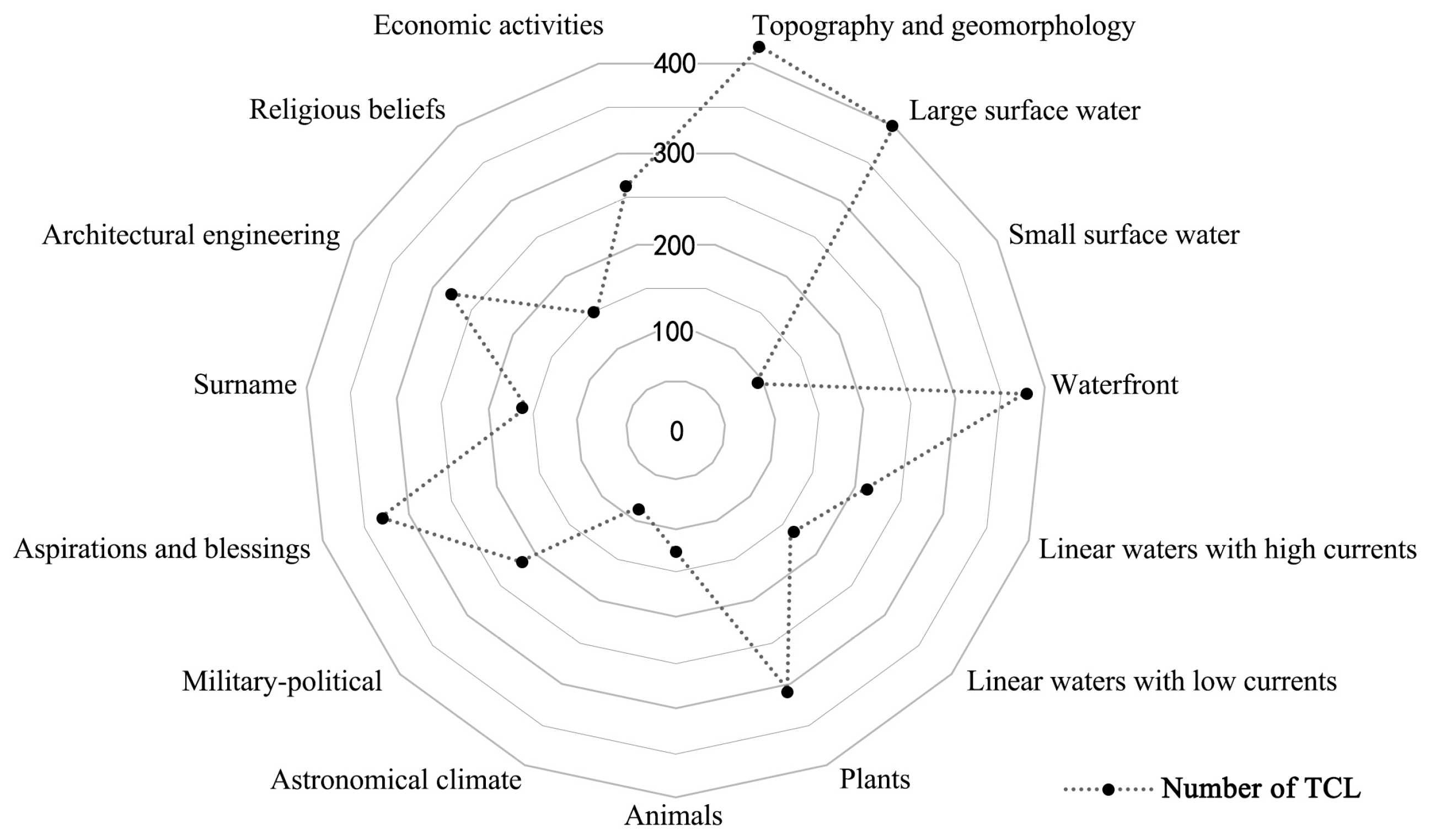

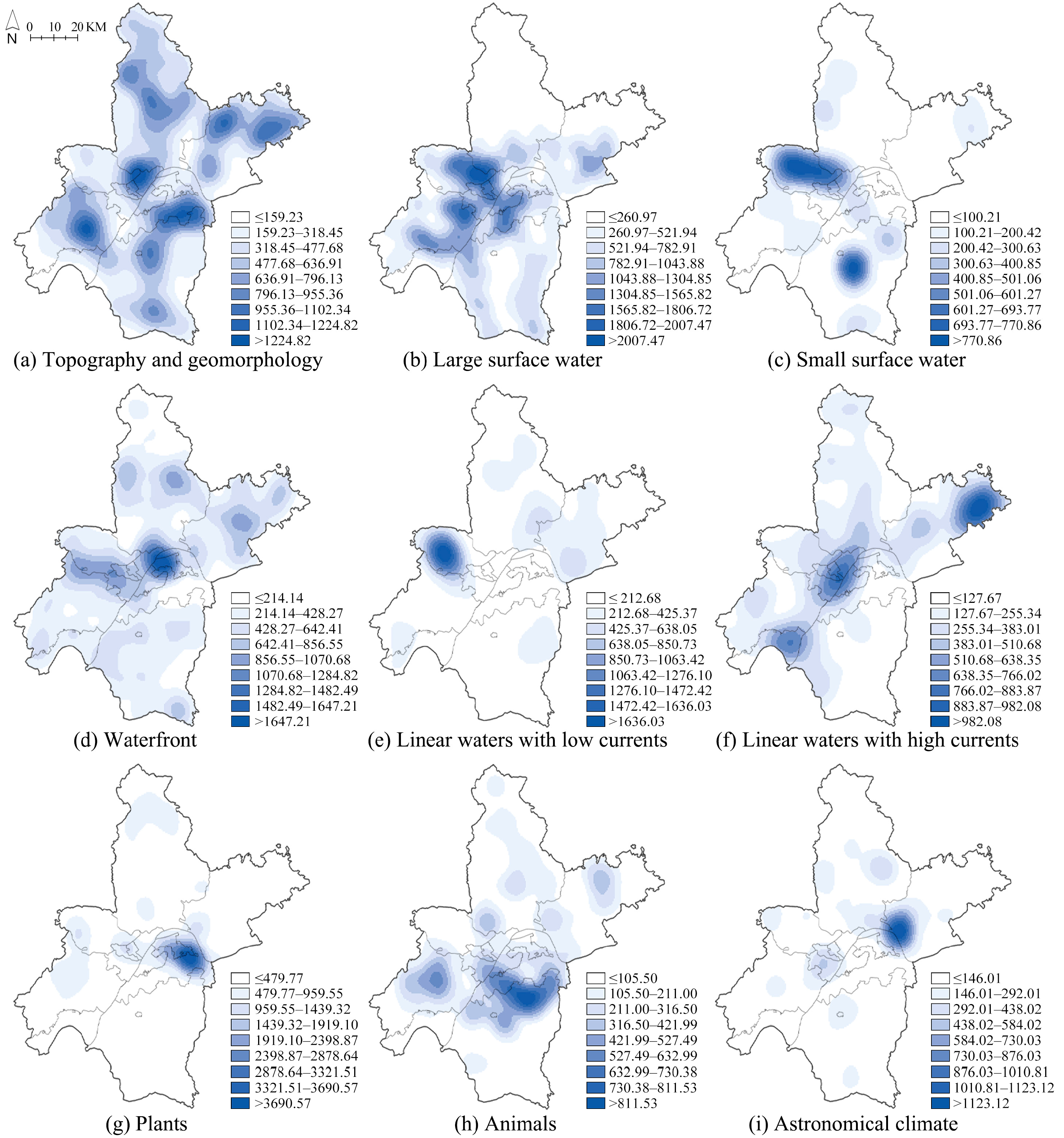
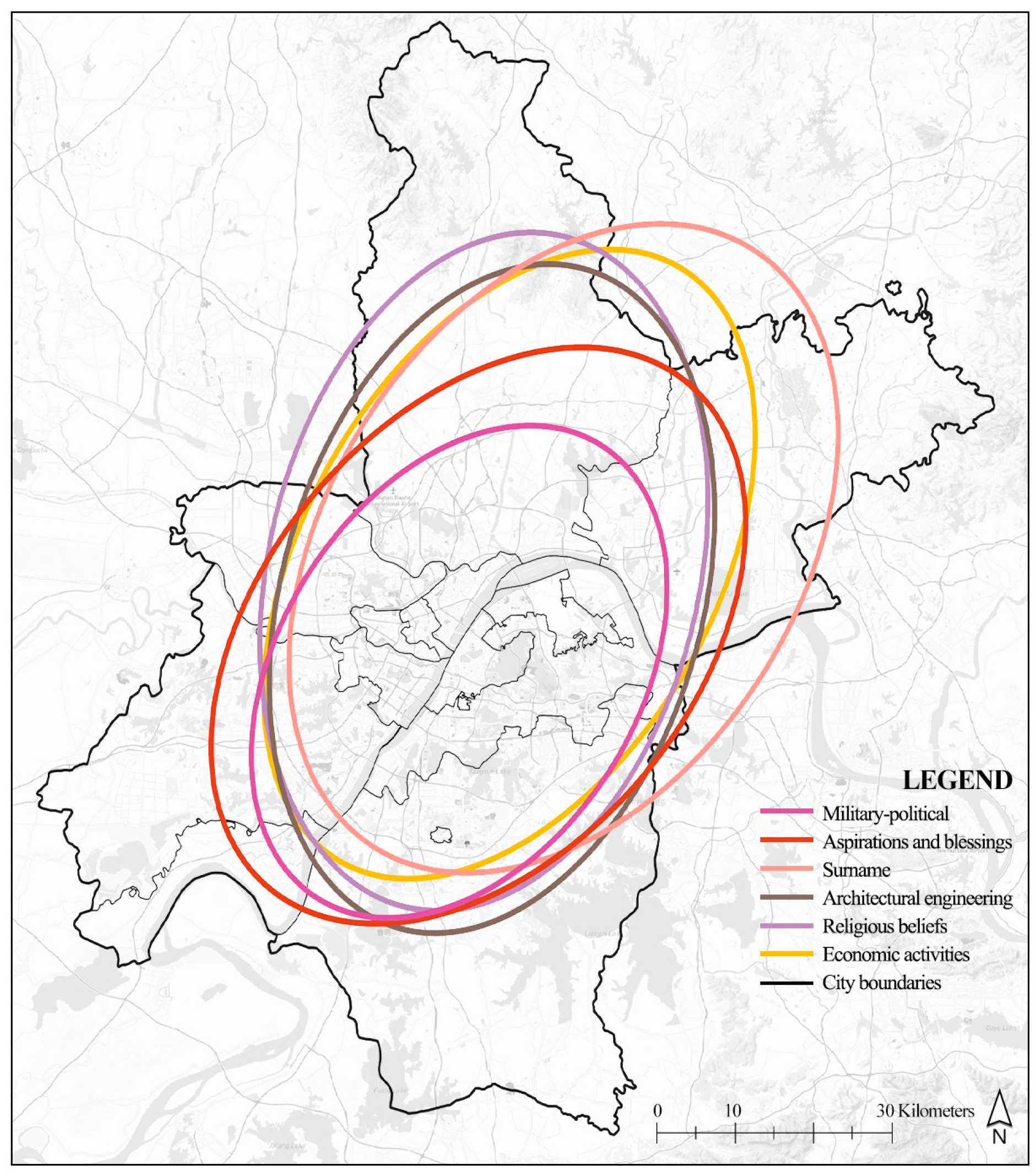



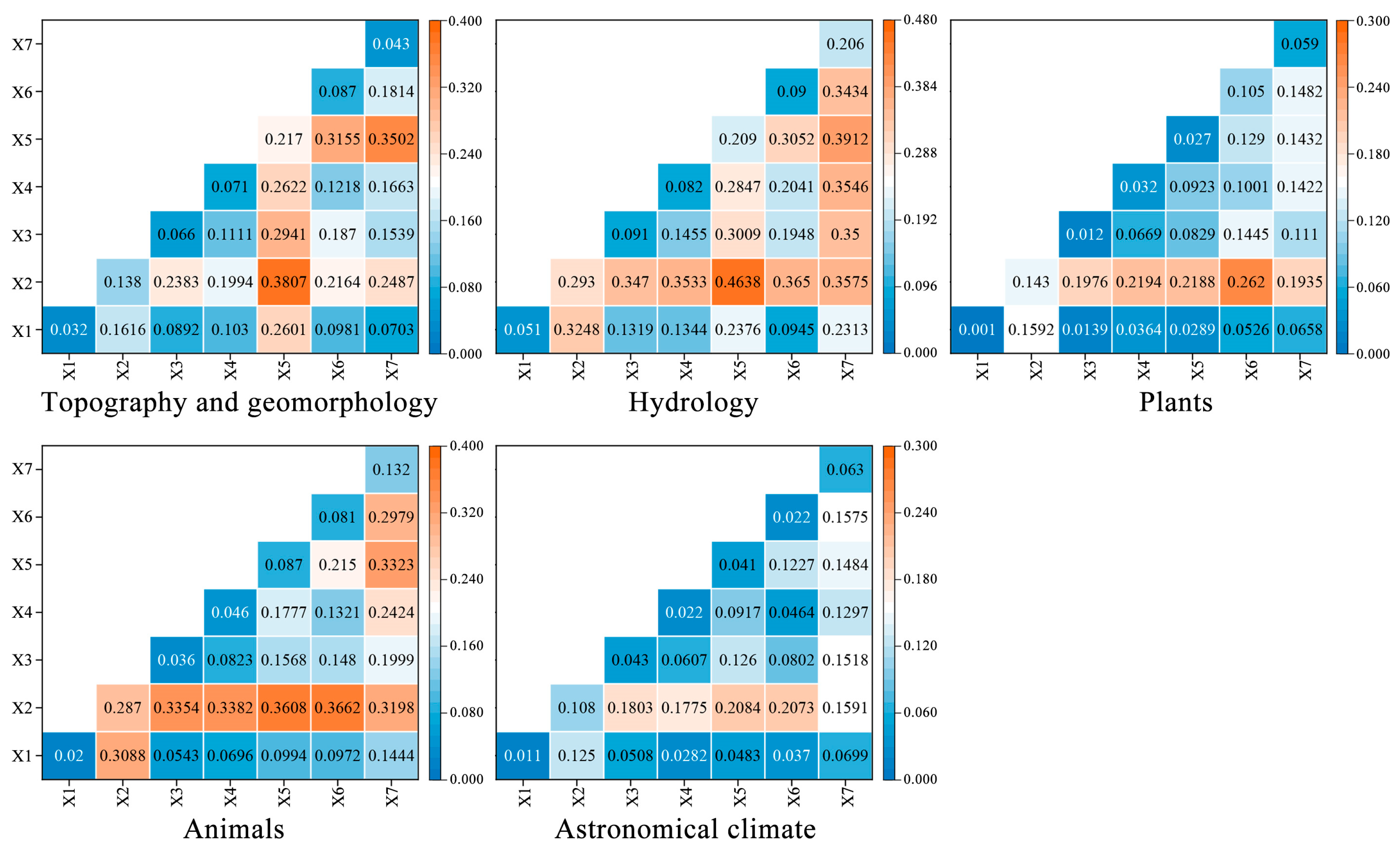
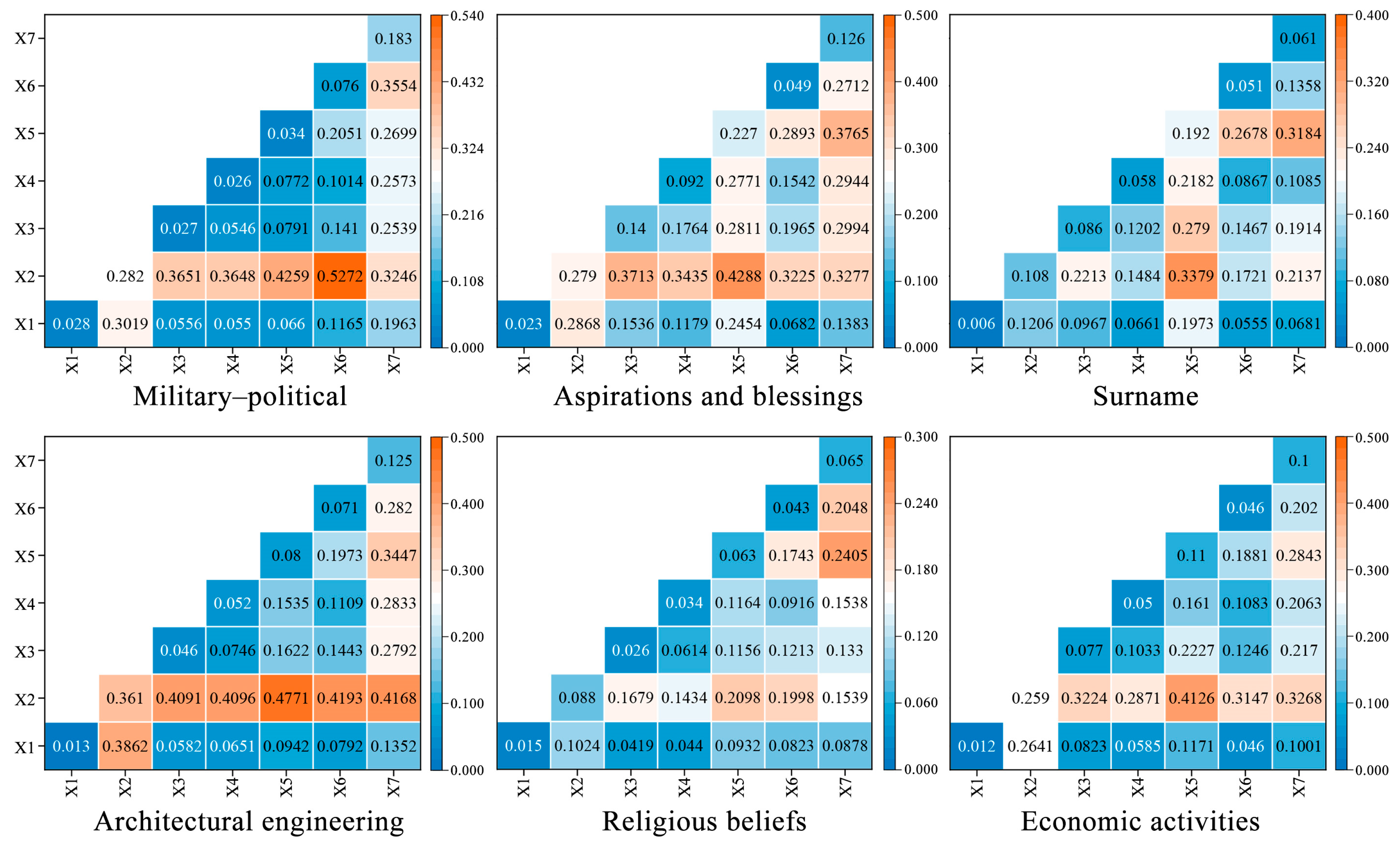
| Type | Definition | |
|---|---|---|
| Natural landscape | Topography and geomorphology | Toponyms describing topographical undulations |
| Large surface water | Toponyms describing extensive and continuous surface water areas | |
| Small surface water | Toponyms describing small-scale and relatively independent surface water areas | |
| Waterfront | Toponyms describing waterfronts, riverbanks, coastlines, and other water–land interchanges | |
| Linear waters with high currents | Toponyms describing rapid and turbulent linear waters | |
| Linear waters with low currents | Toponyms describing slow and gentle linear waters | |
| Plants | Toponyms using the names or characteristics of plants | |
| Animals | Toponyms using the names or characteristics of animals | |
| Humanistic landscape | Astronomical climate | Toponyms describing astronomical or climatic phenomena |
| Military–political | Toponyms describing military activities or political events | |
| Aspirations and blessings | Toponyms expressing wishes for blessings | |
| Surname | Toponyms named after clan surnames | |
| Architectural engineering | Toponyms named after specific types of buildings (excluding military and political structures) | |
| Religious beliefs | Toponyms describing religious faith activities or venues | |
| Economic activities | Toponyms describing specific economic activities or venues | |
| Type | Subtype | Tertiary Type | Words/Phrases That Occur More Frequently | Quantity | % |
|---|---|---|---|---|---|
| Natural landscape | Topography and geomorphology | Mountain (山), Ridge (岭), Knoll (岗), Hollow (冲), Recess (塆), Mound (墩), Rock (石), Peak (岱), Summit (峰), Soil (土), Hill (丘), Col (坳), Cliff (陡), Valley (谷) | 420 | 11.54 | |
| Hydrology | Waterfront | Shore (岸), Dam (坝), Waterfront (滨), Levee (堤), Ferry Crossing (渡), Mudflat (沌), Harbor (港), Estuary (浦), River (泗), Beach/Mudflat (滩), Bay (湾), Weir (堰), Sluice Gate (闸) | 382 | 10.50 | |
| Large surface water | Ocean (洋), Lake (湖), Sea (海), Sai (赛) | 400 | 11.00 | ||
| Small surface water | Pond (塘), Spring (泉), Pool (池), Dangzi (荡子) | 106 | 2.91 | ||
| Linear waters with low currents | Creek (溪), Gully (沟), Canal (渠), Point (咀), Ravine (涧), Distributary (汊) | 172 | 4.73 | ||
| Linear waters with high currents | Chuan (川), River (河), Major River (江) | 214 | 5.88 | ||
| Plants | Cedar (柏), Maple (枫), Osmanthus (桂), Lotus (荷), Locust Tree (槐), Orchid (兰), Lotus (莲), Willow (柳), Plum (梅), Persimmon (柿), Sandalwood (檀), Crabapple (棠), Peach (桃), Camphor Tree (樟), Bamboo (竹) | 307 | 8.44 | ||
| Animals | Leopard (豹), Phoenix (凤), Crane (鹤), Tiger (虎), Oriole (鹂), Loong (龙), Deer (鹿), Horse (马), Lion (狮), Ostrich (鸵), Crow (鸦), Goose (雁), Sheep (羊) | 132 | 3.63 | ||
| Humanistic landscape | Astronomical climate | Sun (阳), Star (星), Cloud (云), Moon (月), Wind (风), Rain (雨) | 92 | 2.53 | |
| Military–political | Fort (堡), Prefecture (府), Workers and Peasants (工农), Official (官), Trench (壕), Army (军), First Uprising (首义), Patrol (巡), Vanguard (先锋), Hero (英雄), Post Station (驿), Leap Forward (跃进) | 224 | 6.16 | ||
| Aspirations and blessings | Happiness (福), Morality (德), Rich (富), Sweet Dew (甘露), Glory (光辉), Light (光明), Peace (和平), Joy (欢乐), Diligence (勤), Dawn (曙光), Unity (团结), Future (未来), Happiness (幸福), Fulfill dreams (圆梦) | 333 | 9.15 | ||
| Surname | Bao (鲍), Cai (蔡), Chen (陈), Deng (邓), Ding (丁), Dong (董), Fang (方), Feng (冯), Fu (付), Hu (胡), Liu (刘), Liao (廖), Pan (潘), Luo (罗), Peng (彭), Song (宋), Qiu (邱), Tu (涂), Yue (岳), Yao (姚), Tao (陶), Yuan (袁), Zhang (章), Ye (叶), Zhao (赵) | 160 | 4.40 | ||
| Architectural engineering | Bridge (桥), Shed (棚), Pavilion (亭), Yard (院), Tile (瓦), House (屋), Building (楼), Gate (门), Room (房), City (城), Boat (船), Belvedere (阁), Alley (巷), Terrace (台), Station (站) | 282 | 7.75 | ||
| Religious beliefs | Daoist Temple (观), Monk (和尚), Temple (庙), Hermitage (茅), Monastery (寺), Deity (神), Pagoda (塔), Buddha Hall (堂), Nunnery (庵), Zen (禅), Ancestral Hall (祠), Buddha (佛) | 150 | 4.12 | ||
| Economic activities | Market (市), Farmland (田), Fishery (渔), Paper Industry (纸), Village (庄), Merchant (商), Garden (园), Fair (集), Cultivation (稼), Mine (矿), Grain (粮), Plot (圃), Farmer (农), Factory (厂), Shop (店), Workshop (坊) * | 264 | 7.26 |
| No. | Types | (km) | (km) | Z-Score | p-Value | Pattern | |
|---|---|---|---|---|---|---|---|
| 1 | Topography and geomorphology | 2.02 | 2.62 | 0.77 | −9.06 | 0.00 | Clustered |
| 2 | Large surface water | 1.88 | 2.56 | 0.73 | −10.22 | 0.00 | Clustered |
| 3 | Small surface water | 3.25 | 4.81 | 0.67 | −6.41 | 0.00 | Clustered |
| 4 | Waterfront | 2.15 | 2.69 | 0.80 | −7.49 | 0.00 | Clustered |
| 5 | Linear waters with low currents | 2.91 | 3.98 | 0.73 | −6.74 | 0.00 | Clustered |
| 6 | Linear waters with high currents | 2.70 | 3.58 | 0.75 | −6.91 | 0.00 | Clustered |
| 7 | Plants | 1.90 | 3.00 | 0.63 | −12.35 | 0.00 | Clustered |
| 8 | Animals | 3.07 | 4.33 | 0.71 | −6.38 | 0.00 | Clustered |
| 9 | Astronomical climate | 3.71 | 4.47 | 0.83 | −3.09 | 0.00 | Clustered |
| No. | Type | (km) | (km) | Z-Score | p-Value | Pattern | |
|---|---|---|---|---|---|---|---|
| 1 | Military–political | 2.27 | 3.55 | 0.64 | −10.37 | 0.00 | Clustered |
| 2 | Aspirations and blessings | 2.08 | 2.85 | 0.73 | −9.42 | 0.00 | Clustered |
| 3 | Surname | 3.09 | 4.00 | 0.77 | −5.51 | 0.00 | Clustered |
| 4 | Architectural engineering | 2.09 | 3.18 | 0.66 | −11.07 | 0.00 | Clustered |
| 5 | Religious beliefs | 2.89 | 4.40 | 0.66 | −8.04 | 0.00 | Clustered |
| 6 | Economic activities | 2.51 | 3.12 | 0.80 | −6.24 | 0.00 | Clustered |
| Independent Variable | Factor Index |
|---|---|
| X1 | Unused land |
| X2 | Construction land |
| X3 | Slope |
| X4 | Aspect |
| X5 | Elevation |
| X6 | River density |
| X7 | Normalized difference vegetation index (NDVI) |
| Type | Targets | X1 | X2 | X3 | X4 | X5 | X6 | X7 |
|---|---|---|---|---|---|---|---|---|
| Topography and geomorphology | Q Value | 0.032 | 0.138 | 0.066 | 0.071 | 0.217 | 0.087 | 0.043 |
| p Value | 0.636 | 0.000 | 0.000 | 0.000 | 0.000 | 0.000 | 0.000 | |
| Hydrology | Q Value | 0.051 | 0.293 | 0.091 | 0.082 | 0.209 | 0.090 | 0.206 |
| p Value | 0.510 | 0.000 | 0.000 | 0.000 | 0.000 | 0.000 | 0.000 | |
| Plants | Q Value | 0.001 | 0.143 | 0.012 | 0.032 | 0.027 | 0.105 | 0.059 |
| p Value | 1.000 | 0.000 | 0.212 | 0.000 | 0.000 | 0.000 | 0.000 | |
| Animals | Q Value | 0.020 | 0.287 | 0.036 | 0.046 | 0.087 | 0.081 | 0.132 |
| p Value | 0.460 | 0.000 | 0.000 | 0.000 | 0.000 | 0.000 | 0.000 | |
| Astronomical climate | Q Value | 0.011 | 0.108 | 0.043 | 0.022 | 0.041 | 0.022 | 0.063 |
| p Value | 0.742 | 0.000 | 0.000 | 0.012 | 0.000 | 0.010 | 0.000 |
| Type | Targets | X1 | X2 | X3 | X4 | X5 | X6 | X7 |
|---|---|---|---|---|---|---|---|---|
| Military–political | Q Value | 0.028 | 0.282 | 0.027 | 0.026 | 0.034 | 0.076 | 0.183 |
| p Value | 0.062 | 0.000 | 0.000 | 0.001 | 0.000 | 0.000 | 0.000 | |
| Aspirations and blessings | Q Value | 0.023 | 0.279 | 0.140 | 0.092 | 0.227 | 0.049 | 0.126 |
| p Value | 0.604 | 0.000 | 0.000 | 0.000 | 0.000 | 0.000 | 0.000 | |
| Surname | Q Value | 0.006 | 0.108 | 0.086 | 0.058 | 0.192 | 0.051 | 0.061 |
| p Value | 0.893 | 0.000 | 0.000 | 0.000 | 0.000 | 0.000 | 0.000 | |
| Architectural engineering | Q Value | 0.013 | 0.361 | 0.046 | 0.052 | 0.080 | 0.071 | 0.125 |
| p Value | 0.922 | 0.000 | 0.000 | 0.000 | 0.000 | 0.000 | 0.000 | |
| Religious beliefs | Q Value | 0.015 | 0.088 | 0.026 | 0.034 | 0.063 | 0.043 | 0.065 |
| p Value | 0.589 | 0.000 | 0.005 | 0.000 | 0.000 | 0.000 | 0.000 | |
| Economic activities | Q Value | 0.012 | 0.259 | 0.077 | 0.050 | 0.110 | 0.046 | 0.100 |
| p Value | 0.991 | 0.000 | 0.000 | 0.000 | 0.000 | 0.000 | 0.000 |
Disclaimer/Publisher’s Note: The statements, opinions and data contained in all publications are solely those of the individual author(s) and contributor(s) and not of MDPI and/or the editor(s). MDPI and/or the editor(s) disclaim responsibility for any injury to people or property resulting from any ideas, methods, instructions or products referred to in the content. |
© 2025 by the authors. Licensee MDPI, Basel, Switzerland. This article is an open access article distributed under the terms and conditions of the Creative Commons Attribution (CC BY) license (https://creativecommons.org/licenses/by/4.0/).
Share and Cite
Zhou, Z.; Yin, B.; Huang, M.; Pan, X.; Yang, D. Exploring the Spatial Distribution of Toponyms and Its Correlation with Landscape Characteristics: A Case Study in Wuhan, China. Heritage 2025, 8, 213. https://doi.org/10.3390/heritage8060213
Zhou Z, Yin B, Huang M, Pan X, Yang D. Exploring the Spatial Distribution of Toponyms and Its Correlation with Landscape Characteristics: A Case Study in Wuhan, China. Heritage. 2025; 8(6):213. https://doi.org/10.3390/heritage8060213
Chicago/Turabian StyleZhou, Zihang, Bidan Yin, Menglin Huang, Xianjie Pan, and Diechuan Yang. 2025. "Exploring the Spatial Distribution of Toponyms and Its Correlation with Landscape Characteristics: A Case Study in Wuhan, China" Heritage 8, no. 6: 213. https://doi.org/10.3390/heritage8060213
APA StyleZhou, Z., Yin, B., Huang, M., Pan, X., & Yang, D. (2025). Exploring the Spatial Distribution of Toponyms and Its Correlation with Landscape Characteristics: A Case Study in Wuhan, China. Heritage, 8(6), 213. https://doi.org/10.3390/heritage8060213







